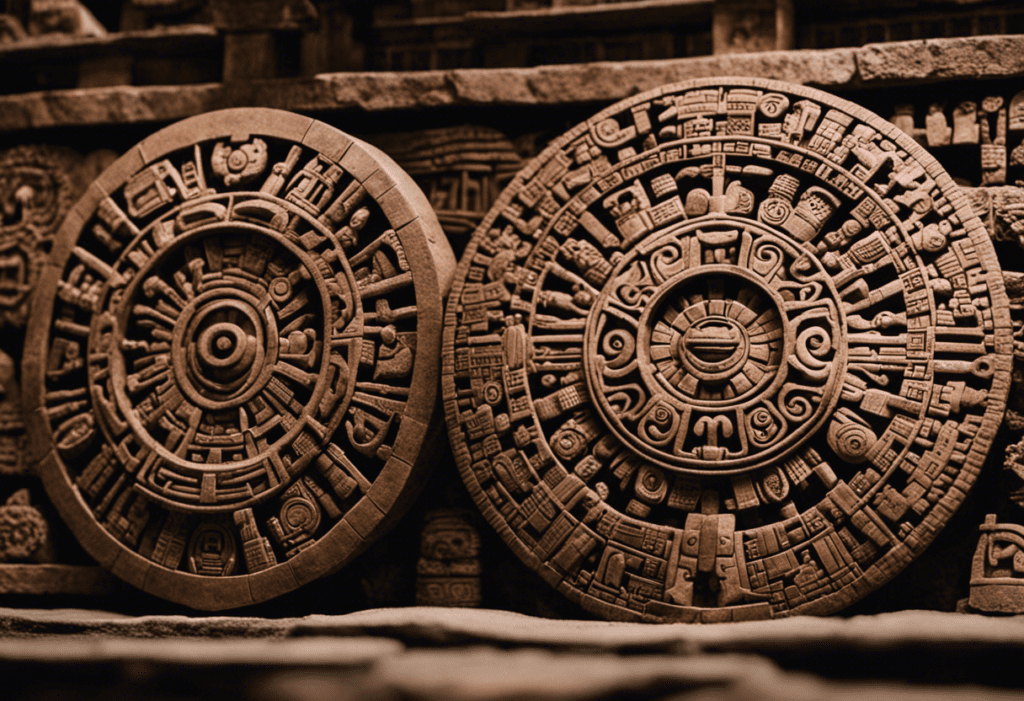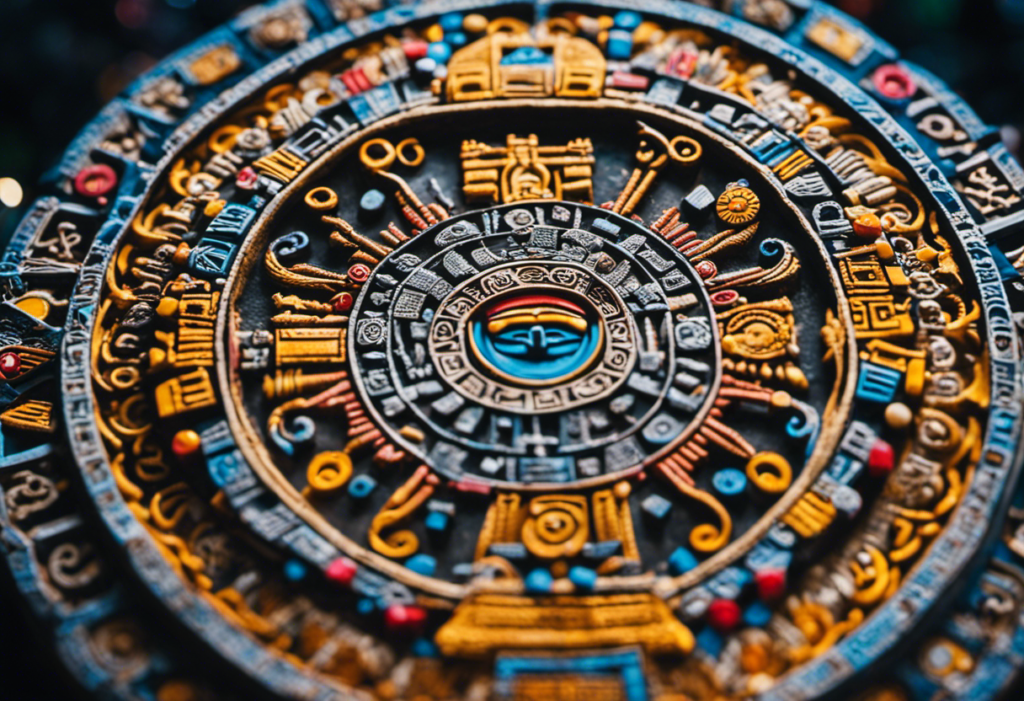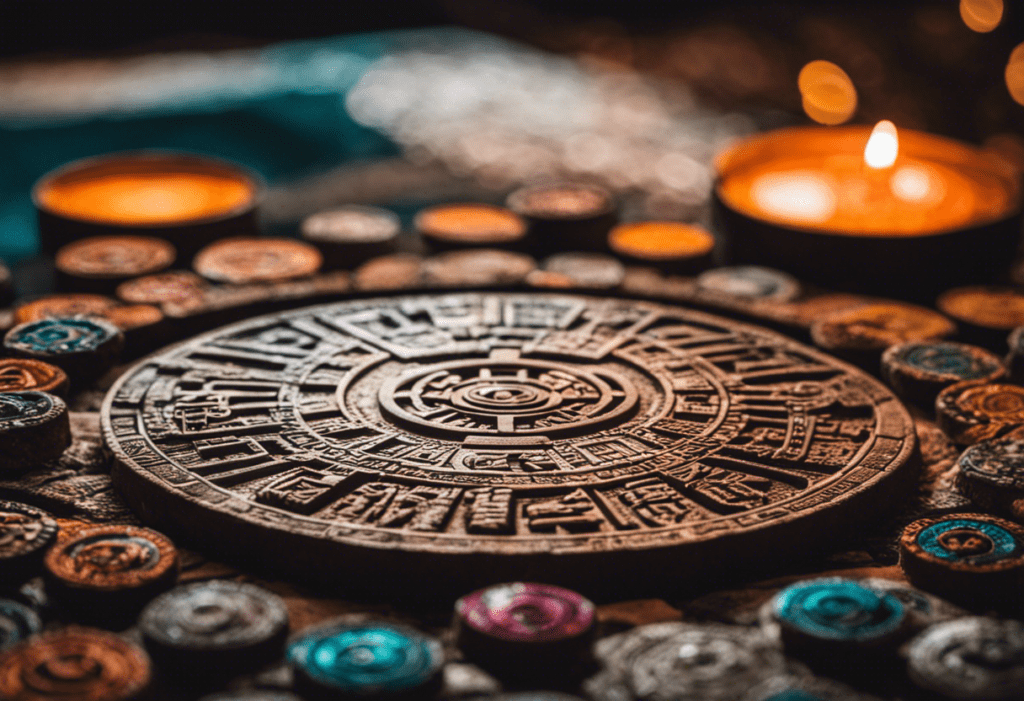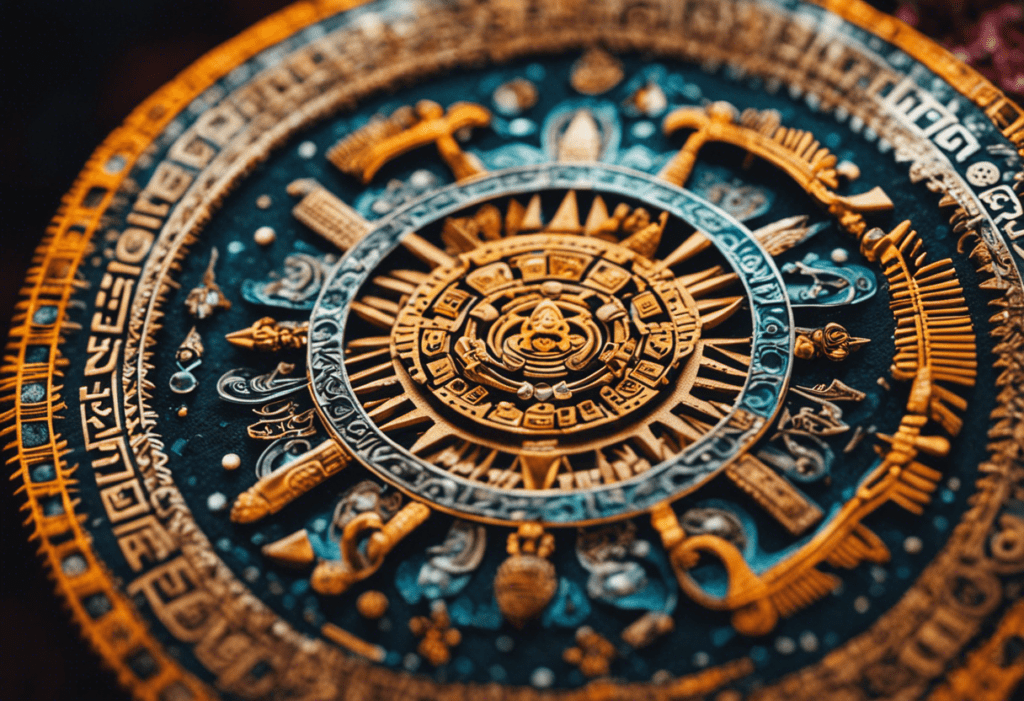Delve into the distinct dimensions of the Aztec and Mayan calendars, unlocking the enigmatic disparities that shaped their ancient civilizations.
This illuminating article meticulously examines the origin, structure, timekeeping, religious significance, celestial alignments, cultural influences, and legacy of these two iconic calendars.
By juxtaposing their intricate designs, this exploration aims to present an evidence-based analysis of the key differences between the Aztec and Mayan calendars, shedding light on their enduring importance and captivating the curious minds of scholars and enthusiasts alike.
Key Takeaways
- The Aztec calendar originated from the Olmec civilization, while the Mayan calendar was refined and expanded upon by the Mayans.
- Both calendars were influenced by celestial events and religious beliefs, with the Aztecs believing that celestial bodies affected human lives and the Mayans believing that gods controlled the passage of time in cycles.
- The Mayan calendar was based on cycles and numbers and represented through hieroglyphic inscriptions, while the Aztec calendar was a circular stone carving that depicted the Aztec worldview and the cyclical nature of the universe.
- Both the Aztec and Mayan calendars had a 260-day cycle, with the Aztec calendar using a combination of 20 day signs and 13 numbers and the Mayan calendar using the same combination. Both calendars were used for religious and ceremonial purposes and determined auspicious dates for ceremonies and rituals.
Origin and Development
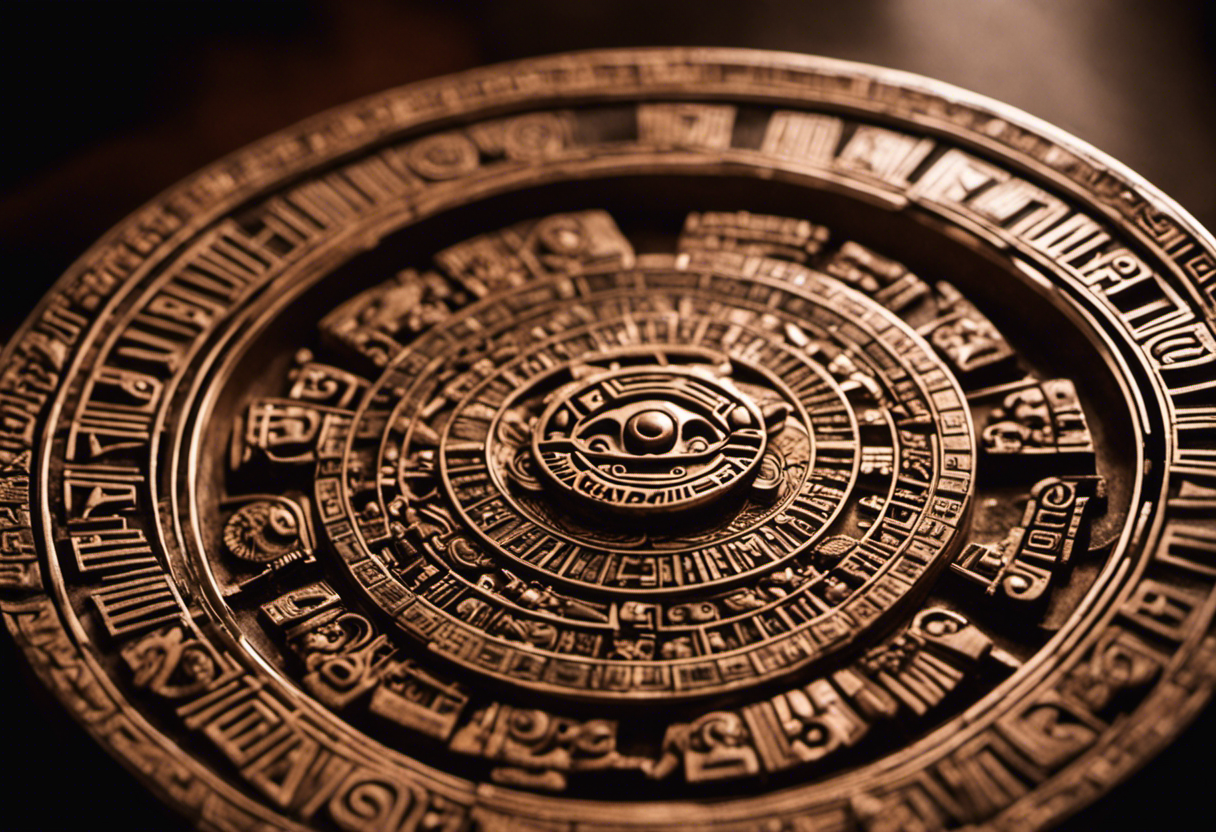

During the centuries leading up to the arrival of Spanish conquistadors in the 16th century, both the Aztec and Mayan calendars underwent significant origin and development.
The origins of the Aztec calendar can be traced back to the Olmec civilization, who were known for their advanced understanding of astronomy. The Aztecs built upon this knowledge and developed a highly sophisticated calendar system that was based on a combination of solar and ritual cycles.
The Mayan calendar, on the other hand, has its origins in the Olmec and Zapotec cultures, but the Mayans further refined and expanded upon it to create one of the most accurate and complex calendar systems in the ancient world.
Both the Aztec and Mayan calendars were influenced by celestial events and religious beliefs. The Aztecs believed that the movements of the celestial bodies directly affected human lives and that it was essential to align their actions with these celestial cycles. Similarly, the Mayans believed that the gods controlled the passage of time and that the calendar was a way to communicate with these deities.
The Mayans also believed that time was cyclical and that history repeated itself in a series of cycles.
Structure and Design
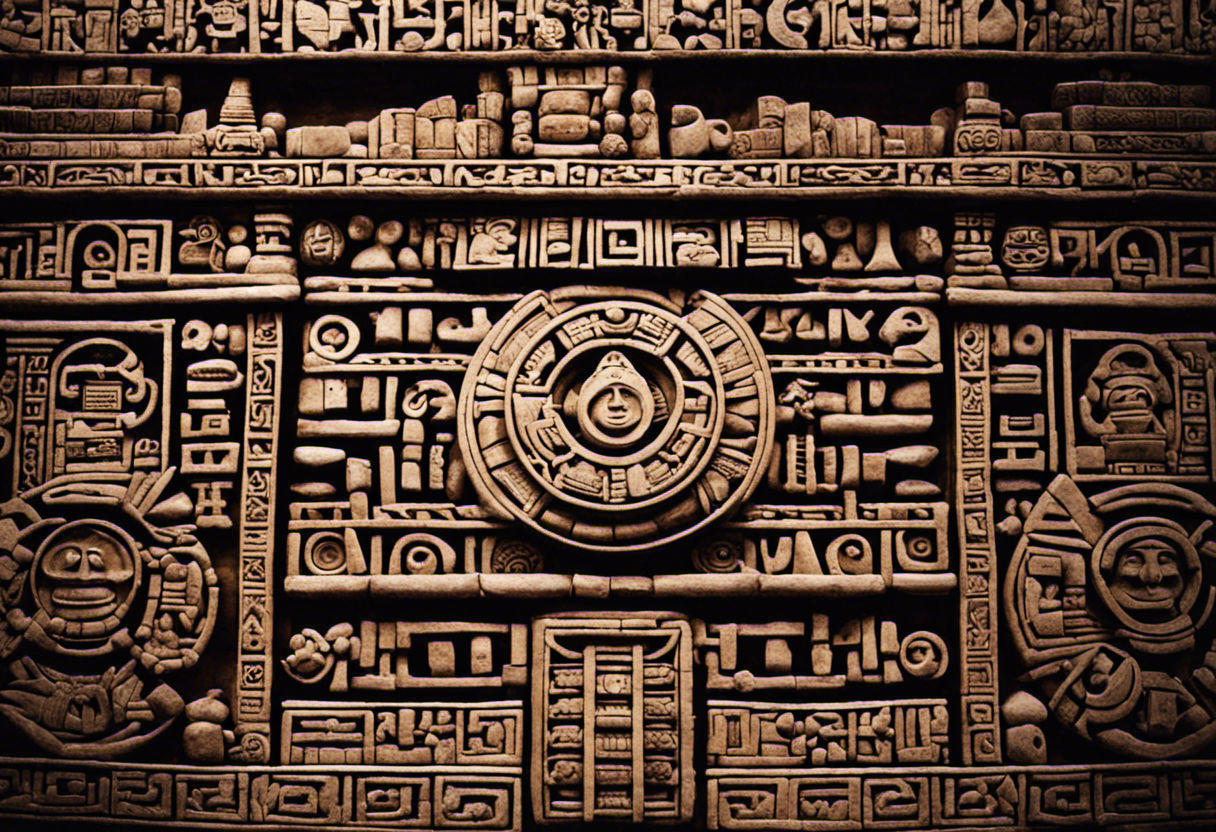

The structure and design of the Aztec and Mayan calendars differ significantly in terms of their visual representation and organization. Both calendars were highly sophisticated and played crucial roles in the respective civilizations.
The Mayan calendar, known as the ‘Long Count’ calendar, was based on a system of cycles and series of numbers. It consisted of several interlocking cycles of different lengths, with each cycle representing a specific unit of time. This complex system allowed the Mayans to accurately track astronomical events, such as the movements of the sun, moon, and planets. The Mayan calendar was primarily represented through hieroglyphic inscriptions on stone stelae and codices. These inscriptions depicted the cycles and dates in a highly artistic manner, often incorporating intricate symbols and images.
In contrast, the Aztec calendar, also known as the ‘Sun Stone’ or ‘Stone of the Five Eras,’ was a circular stone carving that represented the Aztec understanding of time and cosmology. The calendar consisted of concentric circles, each containing various glyphs and symbols that represented different aspects of the Aztec worldview. The central element of the calendar was the face of the sun god Tonatiuh, surrounded by elaborate artistic elements that symbolized the four eras of creation and destruction. The Aztec calendar was not just a practical tool for measuring time but also had immense cultural significance, representing the Aztec understanding of the cyclical nature of the universe and their place within it.
Timekeeping and Measurement
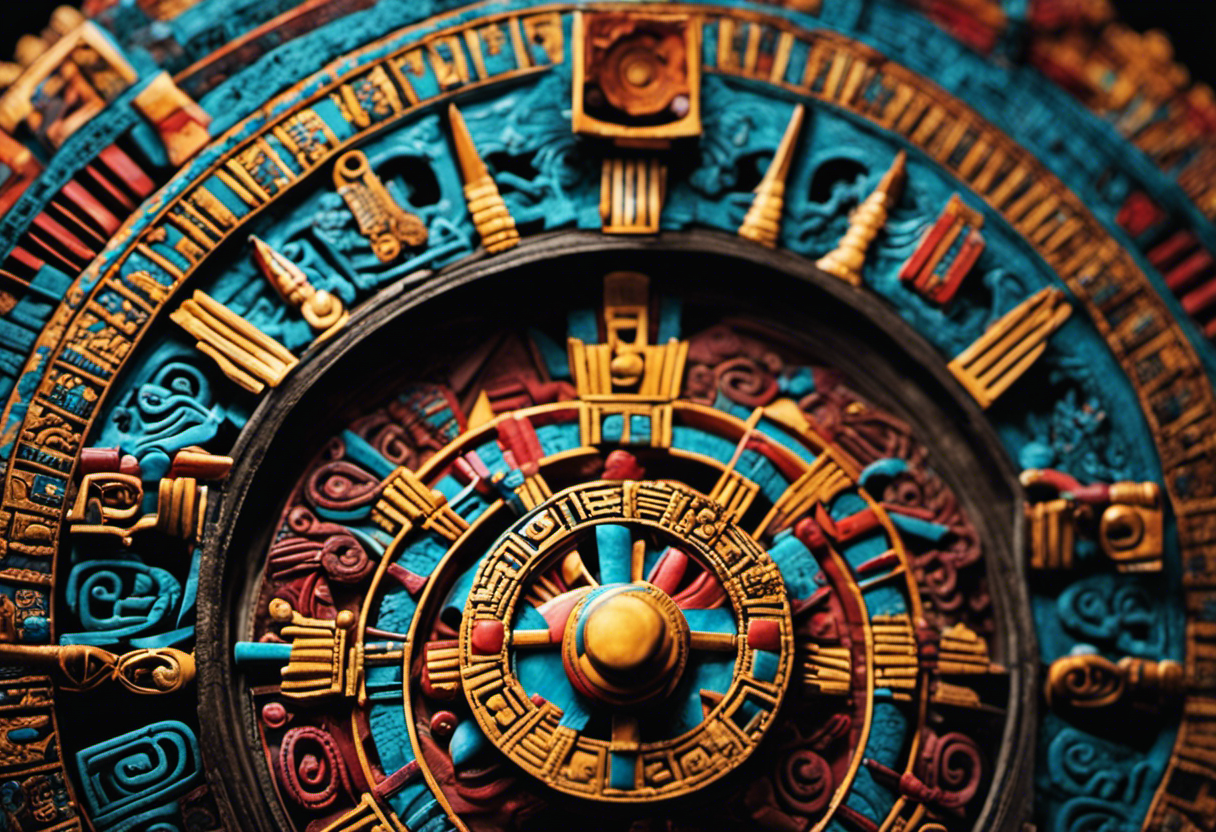

An important aspect of timekeeping and measurement in both the Aztec and Mayan calendars was their ability to accurately track celestial events and astronomical phenomena. These ancient civilizations developed intricate systems of timekeeping that were deeply rooted in their cultural traditions.
The Aztec calendar, known as the tonalpohualli, consisted of 260 days and was primarily used for religious and ceremonial purposes. It was based on the combination of 20 day signs and 13 numbers, resulting in a unique combination for each day of the calendar. This allowed the Aztecs to track the movements of celestial bodies and align important events with specific days in their calendar.
Similarly, the Mayan calendar, known as the Tzolk’in, also had a 260-day cycle. It utilized a combination of 20 day signs and 13 numbers, similar to the Aztec calendar. The Mayans believed that these combinations influenced the characteristics and destinies of individuals born on specific days. In addition to the Tzolk’in, the Mayans also developed the Haab, a solar calendar with 365 days, which they used for agricultural purposes.
Both the Aztec and Mayan calendars reflect the advanced knowledge and understanding of celestial events by these ancient civilizations. Their ability to accurately measure time and track astronomical phenomena demonstrates their complex cultural traditions and their deep connection to the cosmos.
Religious Significance
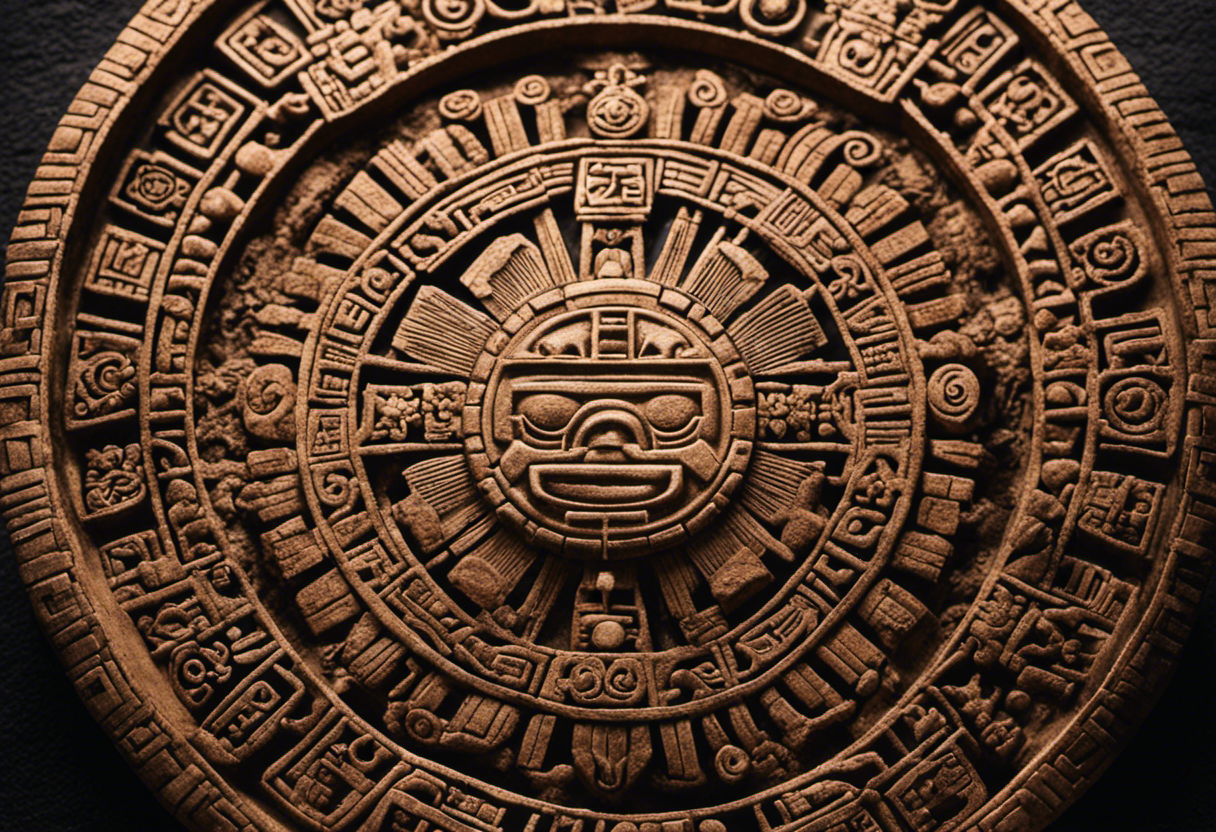

With regards to religious significance, both the Aztec and Mayan calendars played integral roles in the spiritual practices and rituals of their respective civilizations. The calendars were not only used for timekeeping and measurement but also held profound symbolic meanings and were closely intertwined with religious beliefs.
For the Aztecs, the calendar was seen as a divine tool that allowed them to connect with the gods and understand the cyclical nature of life and the universe. The calendar was used to determine auspicious dates for important ceremonies and rituals, such as agricultural festivals, religious sacrifices, and the coronation of rulers. It was believed that by following the calendar and performing the necessary rituals, the Aztecs could maintain the cosmic balance and ensure the favor of the gods.
Similarly, the Mayan calendar held deep religious significance. It was believed to be a reflection of the divine order and cosmic cycles. The Mayans believed that time was cyclical, consisting of repeating cycles of creation, destruction, and rebirth. The calendar was used to track these cycles and determine the most propitious moments for religious ceremonies, such as offerings, divination, and even human sacrifices. The Mayans believed that by aligning their actions with the calendar, they could appease the gods and ensure the well-being of their communities.
Celestial Alignments and Predictions
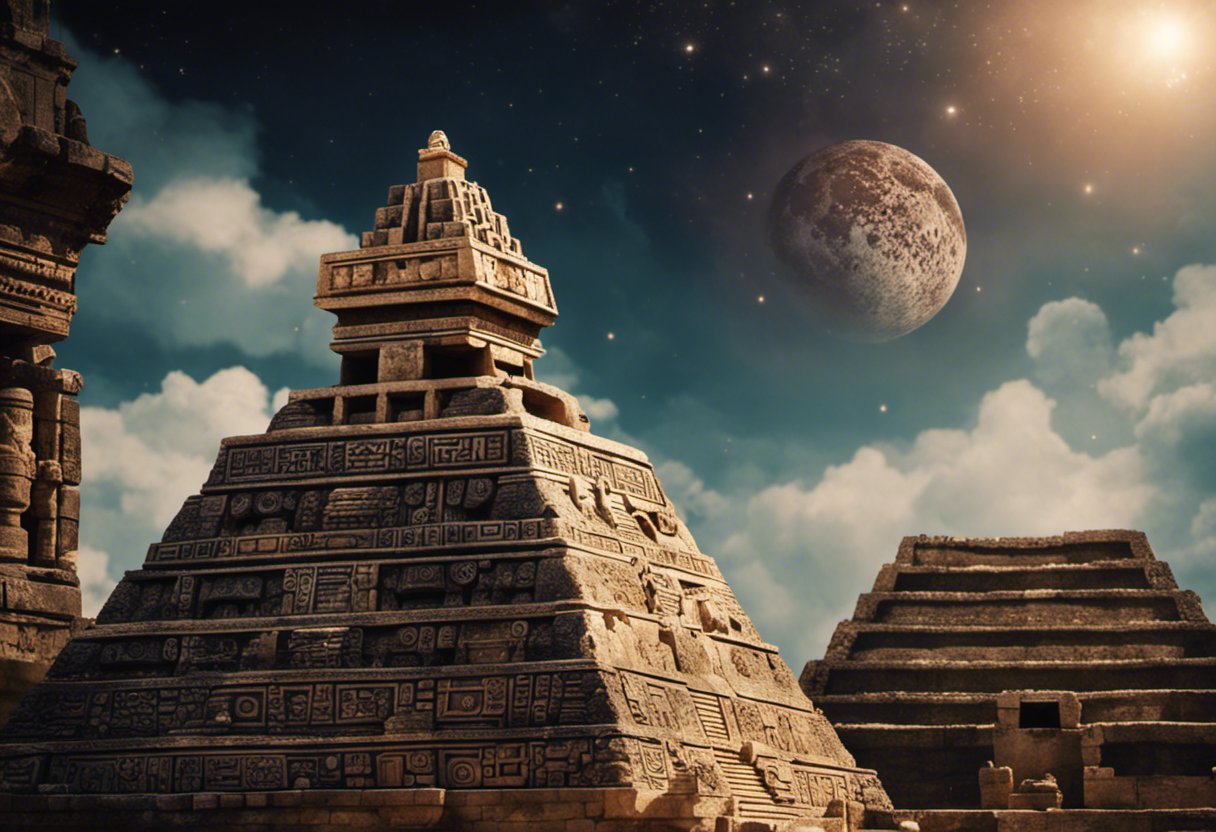

Celestial alignments played a significant role in both the Aztec and Mayan calendars. These ancient civilizations incorporated celestial symbolism into their calendar systems, often associating specific astronomical events with important religious and cultural meanings.
While both calendars made predictions based on celestial observations, the accuracy of these predictions varied.
Further exploration of the celestial alignments and interpretations in the Aztec and Mayan calendars will shed light on the fascinating connections between these ancient civilizations and the cosmos.
Celestial Symbolism in Calendars
What are the main differences in the celestial symbolism found in the Aztec and Mayan calendars, specifically in regards to celestial alignments and predictions?
The celestial symbolism in the Aztec and Mayan calendars was influenced by their respective cultural beliefs and practices. Both civilizations placed great importance on celestial events and incorporated them into their calendars.
However, there are some notable differences in how they interpreted and used celestial alignments and predictions.
The Aztecs, for example, focused on the movements of the sun and moon, using them to determine the timing of religious ceremonies and agricultural activities.
On the other hand, the Mayans had a more complex system that incorporated multiple celestial bodies such as Venus and the Pleiades. They believed that these celestial alignments could provide insights into the future and were used for divination and prophecy.
Astronomical Events and Interpretations
The astronomical events and interpretations found in the Aztec and Mayan calendars reveal significant differences in the way celestial alignments and predictions were understood and utilized by each civilization. These variations can be attributed to the diverse cultural interpretations and symbolic significance assigned to celestial phenomena.
- Astronomical symbolism: The Aztecs and Mayans both incorporated astronomical symbolism into their calendars, but with distinct differences. The Aztecs placed a strong emphasis on solar and lunar cycles, using them to determine auspicious times for religious rituals and agricultural activities. In contrast, the Mayans focused more on the movement of Venus, which they believed influenced human destiny and played a crucial role in their understanding of time.
- Cultural interpretations: The Aztecs and Mayans had different interpretations of celestial events. The Aztecs believed that celestial alignments and phenomena were directly linked to the actions of their deities and used these observations to predict future events and make important decisions. On the other hand, the Mayans saw celestial events as symbolic representations of their mythological stories and used them to guide their social and religious practices.
- Predictions: While both civilizations used astronomical observations for predictions, their approaches differed. The Aztecs relied on a combination of celestial events and divination techniques to make predictions about the future, including weather patterns, agricultural yields, and political events. In contrast, the Mayans developed a highly sophisticated system of astronomy that allowed them to accurately predict celestial events such as eclipses and planetary alignments, which they used to create precise calendars and mark significant dates.
Accuracy of Celestial Predictions
The accuracy of celestial predictions varied between the Aztec and Mayan calendars, reflecting the differing levels of precision and methodologies employed by each civilization.
Both the Aztecs and the Maya were skilled astronomers who observed and recorded celestial phenomena. However, the Mayan calendar was known for its remarkable accuracy in predicting celestial alignments and events.
Their calendar system, based on complex mathematical calculations and astronomical observations, allowed them to accurately predict solstices, equinoxes, and eclipses. The Maya also had a deep understanding of celestial cycles and were able to accurately predict the paths of Venus and other celestial bodies.
On the other hand, while the Aztec calendar also incorporated celestial observations, it was not as precise or advanced as the Mayan calendar.
Therefore, in terms of historical accuracy, the Mayan calendar was more reliable in predicting celestial phenomena than the Aztec calendar.
Cultural Influences and Adaptations


Cultural assimilation played a significant role in shaping the divergent developments of the Aztec and Mayan calendars. The influences and adaptations of different cultures had a profound impact on the evolution of these ancient calendars. Here are three key examples:
- Mayan Cultural Influences: The Mayan civilization developed a complex and accurate calendar system that was heavily influenced by their agricultural practices. They incorporated celestial observations and mathematical calculations to track the movements of celestial bodies, which were essential for their agricultural calendar. The Mayans also believed in the cyclical nature of time and saw it as a reflection of the continuous cycle of life and death.
- Aztec Cultural Influences: The Aztecs, a Mesoamerican civilization, borrowed heavily from the Mayan calendar system but also incorporated their own cultural beliefs. They believed that time was a series of cycles and that events would repeat themselves. The Aztec calendar system was adapted to reflect their religious and societal practices. It was used to determine religious festivals, agricultural activities, and even the timing of wars.
- Societal Impact: Both the Mayan and Aztec calendars had a significant impact on their respective societies. The accuracy of the calendars allowed for efficient agricultural planning, which contributed to the economic prosperity of these civilizations. Additionally, the calendars played a crucial role in religious ceremonies and societal events. They provided a sense of order and stability, reinforcing the cultural and social fabric of these ancient civilizations.
Legacy and Modern Interpretations
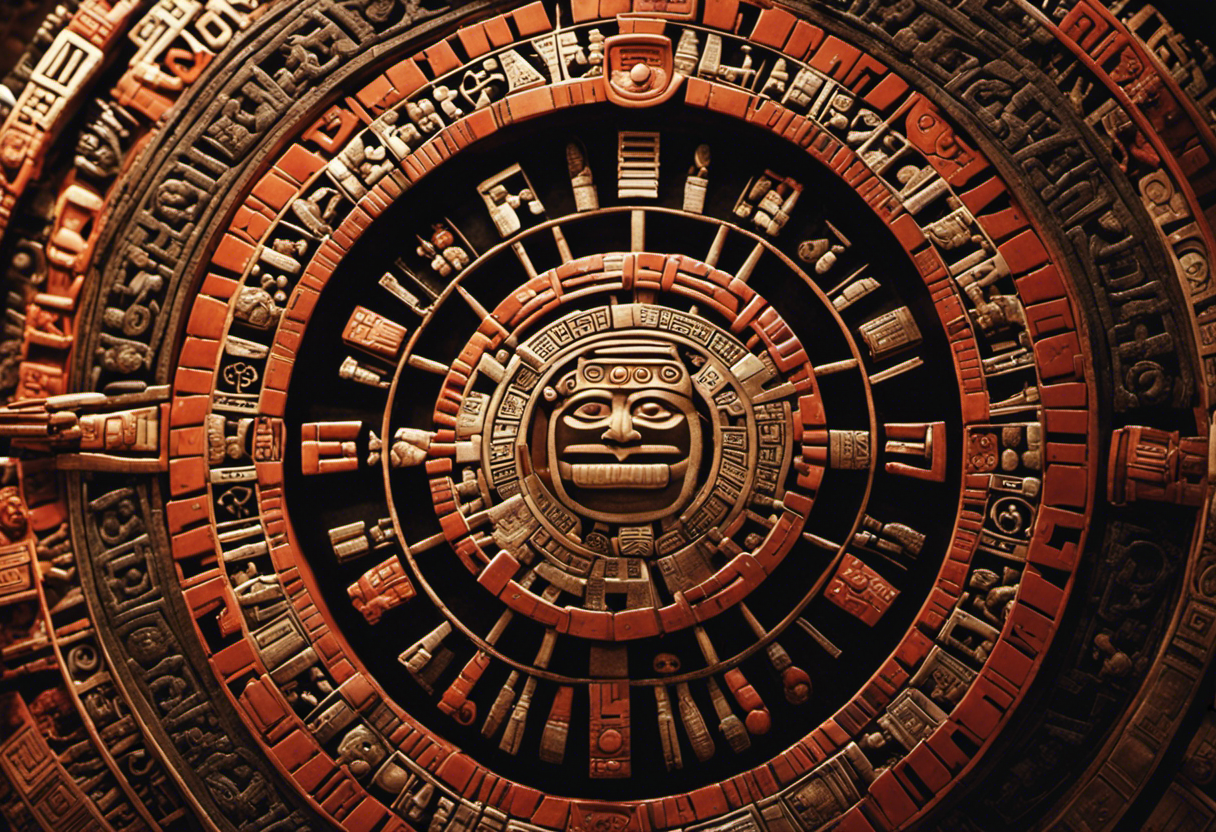

One enduring legacy of the Aztec and Mayan calendars is their continued influence on fields such as archaeology, anthropology, and astronomy. The calendars have provided invaluable insight into the cultures and civilizations of the Aztecs and Mayans, allowing researchers to better understand their beliefs, rituals, and societal structures. The calendars have also sparked interest and curiosity among scholars, leading to ongoing interpretations and analyses.
In terms of legacy interpretations, the Aztec and Mayan calendars have been studied extensively to decipher their complex systems and meanings. Researchers have analyzed the intricate symbols and calculations used in these calendars to gain insight into how the Aztecs and Mayans perceived time, celestial events, and the cyclical nature of life. These interpretations have shed light on the religious and cosmological beliefs of these ancient civilizations.
In addition to legacy interpretations, modern interpretations of the Aztec and Mayan calendars have emerged. These interpretations often seek to connect the ancient calendars with contemporary issues and beliefs. Some modern interpretations involve using the calendars as a guide for personal growth, spiritual development, or divination. Others explore the connection between the calendar symbols and modern astronomical discoveries.
Conclusion
In conclusion, comparing the Aztec and Mayan calendars reveals distinct differences in their origin, structure, timekeeping, religious significance, celestial alignments, and cultural influences.
The Aztec calendar, with its intricate design and emphasis on religious rituals, showcased the Aztec civilization’s hierarchical society and reverence for deities.
On the other hand, the Mayan calendar, renowned for its astronomical accuracy, reflected the Mayan civilization’s advanced understanding of celestial phenomena.
Both calendars have left a profound legacy and continue to be interpreted in modern times, emphasizing the enduring significance of these ancient civilizations.

